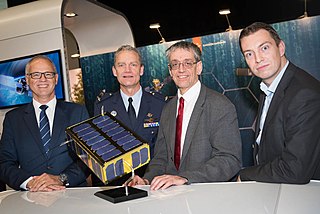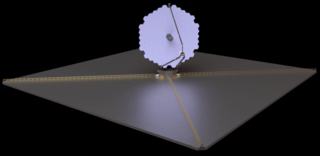 W
WALTIUS is a satellite mission proposed by the Belgian Institute for Space Aeronomy and currently under development by the European Space Agency. Its main objective is to monitor the distribution and evolution of stratospheric ozone in the Earth's atmosphere. The industrial consortium is led by QinetiQ Space, acting as mission prime. The satellite design is based on the PROBA small satellite bus. The payload, developed by OIP Sensor Systems, is an innovative UV, visible and NIR instrument.
 W
WBrik-II will be the first satellite of the Royal Netherlands Air Force. On 30 November 2017 C-LSK Dennis Luyt signed a contract with ISISpace, NLR and TU Delft. The nanosatellite would provide the Royal Netherlands Air Force with intelligence regarding navigation, communication and observation of the Earth. The satellite is scheduled to be launched in the first quarter of 2021.
 W
WCLARREO is a high-priority NASA decadal survey mission, originally selected as such by the National Research Council in 2007. The CLARREO mission is intended to provide a metrology laboratory in orbit to accurately quantify and attribute Earth's climate change. The mission is also designed to transfer its high accuracy to other spaceborne sensors. It would serve as a reference calibration standard in orbit, making climate trends apparent in their data sets within a 30-year time frame. These measurements may go on to enable testing, validation, and improvement of climate model prediction.
 W
WEarthCARE is a planned joint European/Japanese satellite, the sixth of ESA's Earth Explorer Programme. The main goal of the mission is the observation and characterization of clouds and aerosols as well as measuring the reflected solar radiation and the infrared radiation emitted from Earth's surface and atmosphere.
 W
WJPSS-2, or Joint Polar Satellite System-2, is the second of the United States National Oceanic and Atmospheric Administration (NOAA)'s latest generation of U.S. polar-orbiting, non-geosynchronous, environmental satellites called the Joint Polar Satellite System. JPSS-2 is to be launched in 2022 and join NOAA-20 and Suomi NPP in the same orbit. Circling the Earth from pole-to-pole, it will cross the equator about 14 times daily, providing full global coverage twice a day.
 W
WLarge Interferometer For Exoplanets (LIFE) is a project started in 2017 to develop the science, technology and a roadmap for a space mission to detect and characterize the atmospheres of dozens of warm, terrestrial extrasolar planets. The current plan is for a nulling interferometer operating in the mid-infrared consisting of several formation flying collector telescopes with a beam combiner spacecraft at their center.
 W
WThe Large Ultraviolet Optical Infrared Surveyor, commonly known as LUVOIR, is a multi-wavelength space telescope concept being developed by NASA under the leadership of a Science and Technology Definition Team. It is one of four large astrophysics space mission concepts being studied in preparation for the National Academy of Sciences 2020 Astronomy and Astrophysics Decadal Survey. While LUVOIR is a concept for a general-purpose observatory, it has the key science goal of characterizing a wide range of exoplanets, including those that might be habitable. An additional goal is to enable a broad range of astrophysics, from the reionization epoch, through galaxy formation and evolution, to star and planet formation. Powerful imaging and spectroscopy observations of Solar System bodies would also be possible. LUVOIR would be a Large Strategic Science Mission and will be considered for a development start sometime after 2020. The LUVOIR Study Team has produced designs for two variants of LUVOIR: one with a 15 m diameter telescope mirror (LUVOIR-A) and one with an 8 m diameter mirror (LUVOIR-B). LUVOIR can observe ultraviolet, visible, and near-infrared wavelengths of light. The Final Report on the 5-year LUVOIR mission concept study was publicly released on 26 August 2019.
 W
WBusek Co. Inc. is a spacecraft propulsion company providing thrusters, electronics, and complete systems for spacecraft.
 W
WProba-3 is a technological demonstration mission by the European Space Agency devoted to high precision formation flying to achieve scientific Coronagraphy. It is part of the series of PROBA satellites that are being used to validate new spacecraft technologies and concepts while also carrying scientific instruments.
 W
WThe SABIA-Mar, originally called SAC-E by CONAE, is a dual satellite joint Earth observation mission. The mission objective is to study the oceanic biosphere, its changes over time, and how it is affected by and reacts to human activity. It will focus on the monitoring of ocean surfaces, especially studying the ocean ecosystem, the carbon cycle, and marine habitats, as well as ocean mapping.
 W
WSolar wind Magnetosphere Ionosphere Link Explorer (SMILE) is a planned joint venture mission between the European Space Agency and the Chinese Academy of Sciences. SMILE will image for the first time the magnetosphere of the Sun in soft X-rays and UV during up to 40 hours per orbit, improving our understanding of the dynamic interaction between the solar wind and Earth's magnetosphere. The prime science questions of the SMILE mission areWhat are the fundamental modes of the dayside solar wind/magnetosphere interaction? What defines the substorm cycle? How do coronal mass ejection-driven storms arise and what is their relationship to substorms?
 W
WThe Tethered Experiment for Mars inter-Planetary Operations (TEMPO³) is proposed CubeSat-based satellite meant to demonstrate centripetal artificial gravity generation. After launch, the spacecraft will spin end over end to create gravity-like acceleration at both ends of a tether. The project is being run by the Mars Society. It aims building from high-altitude tests to eventual orbital flight. Status is unknown since 2012.
 W
WThe Time-Resolved Observations of Precipitation structure and storm Intensity with a Constellation of Smallsats (TROPICS) mission is a constellation of small satellites planned for launch between on 8 January 2022 and 31 July 2022 that will measure temperature and moisture profiles and precipitation in tropical systems with unprecedented temporal frequency. This data will enable scientists to study the dynamic processes that occur in the inner core of the storm resulting in rapid genesis and intensification. William Blackwell of the Massachusetts Institute of Technology's Lincoln Laboratory in Lexington, Massachusetts is the principal investigator.